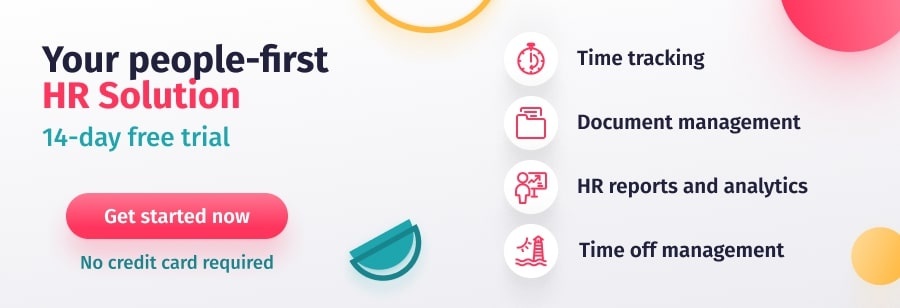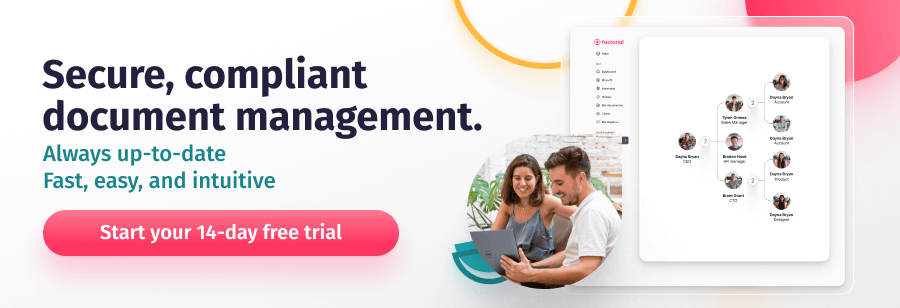As an employer, you have a duty to maintain accurate and up-to-date records of all your employee data. Having access to the right information can help you keep track of important metrics relating to performance and productivity.
A reliable employee file management system also helps you stay compliant with recordkeeping requirements established by a number of employment laws, including the Americans with Disabilities Act (ADA), the Fair Labor Standards Act (FLSA) ), and the Family Medical Leave Act (FLMA). One effective way to maintain accurate and secure records is to use employee record management software.
In this post, we will take a look at the employee file management process and discuss a few HR file management solutions. We will also share some tips on what to look for in employee record management software to help you find the right solution for your business.
What is Employee File Management?
Employee file management is an important aspect of human capital management. Put simply, it is the process of retaining, filing, and organizing employee data collected from each stage of the employee lifecycle. This enables companies to establish controlled access to confidential data and the proper storage of required information. It also includes the secure and timely destruction of obsolete employee data to ensure compliance with a number of wage and employment laws.
Traditionally, employee records were maintained using a manual bookkeeping system. This involved keeping paper records of all employee data in personal files. Each file contained personal and professional information including names, contact information, hiring records, payroll activity, medical documentation, training plans and disciplinary notifications, amongst other data. And all employee files were stored together in a filing cabinet in alphabetical order. This system was cumbersome, time-consuming and unreliable. Not to mention all the space that was required for storage.
These days, most employee data is stored in digital format. An employee database is used to maintain a centralized record of all relevant information, making information much easier to manage and locate. Nonetheless, the effective management of employee data is still one of the most challenging areas of HR administration. This is because you have to find the right balance between meeting both your business needs and regulatory compliance.
One effective way to achieve this is by implementing a comprehensive employee record management system, also known as employee record management software.
What is Employee Record Management Software?
Employee record management software is a digital employee file management system that makes it easy to store, locate and manage employee data.
Think of it like an electronic filing application that helps you record and track all your personal and professional employee data using seamless processes that help your organization run more smoothly. Instead of searching for an employee’s paper file in a huge filing cabinet, you just access their profile from an intuitive platform, and you have all the data at your fingertips.
The data included in each employee’s personal profile usually includes contact information, hiring documentation, attendance and leave records, salary information, medical history, expense management data, overall performance and training requirements.
An effective employee data management solution not only speeds up the administration process but also helps you protect sensitive data and safeguard your company from risk. Plus, having all data securely centralized helps you access the right data when you need it, empowering your leadership team and helping your employees work more efficiently and productively.
Employee File Management Process
Before deciding which employee record management software is the right solution for you, you need to work out a strategy to help you implement your system in the most effective way.
To help you, we have put together the essential steps you need to include in your employee file management process:
- Step 1: Map your documents. Make a list of all the human resource documents you collect for each employee. This probably includes recruiting and hiring documents; employee contracts; personal records; payroll and benefits information; medical and healthcare documents and any safety and accident reports; personnel records including performance reviews and any disciplinary reports; and training records and resources.
- Step 2: Define access needs. Determine who will need to access this data. All employees? Your HR staff only? And how often will they need to access it?
- Step 3: Identify requirements and goals. Work out all expiration dates and triggers for your documents. For example, certain records need to be maintained for a specific period after an employee leaves your company, so termination would be a trigger for those documents. Consider legal requirements for data storage.
- Step 4: Calculate security parameters. What level of security do different document types need? For example, medical data need to be stored separately from employee files. Do documents need password protection? Also, what data needs to be shredded once it becomes obsolete?
- Step 5: Design your storage and archiving strategy. In other words, create your storage, access, workflow, and archiving plans.
- Step 6: Implement an employee record management software solution. This will enable you to automate document generation, access, and workflows.
Benefits of Using Employee Record Management Software
Here are some of the biggest benefits you get when you use employee record management software to manage all your employee data.
Compliance
One of the biggest benefits of using an employee file management system is that it helps you stay compliant with state and federal laws. This includes regulations for timekeeping and recordkeeping. It also includes numerous federal laws which require you to retain employee records for a specific period after termination. For example, under the Fair Labor Standards Act (FLSA), you must keep payroll records for nonexempt employees for three years from termination.
Legal Protection
In addition to federal requirements, you also need access to employee documents for the purpose of regulatory audits and inquiries, employee complaints, and lawsuits. For example, if an employee files a discrimination or unfair dismissal claim, employee record management software helps you produce full HR records promptly.
Security and Privacy
Another advantage of employee record management software is that it protects your data and help you adhere to security and privacy regulations. This includes maintaining the confidentiality of employee medical information, information on disabilities, Social Security numbers, and other personal information.
Data Flow & Administrative Efficiency
Employee record management software streamlines document access and sharing, helping you create more efficient workflows. This helps you stay efficient and organized. It also makes sure the right documents are available to the right people whenever needed.
Moreover, you can easily integrate employee record management software with other existing systems and processes so you can keep track of all data in one place.
What to Look for in Employee Record Management Software
The best HRIS employee record management software integrates all your HR solutions. It should include key features such as time and attendance management, absence and leave management, an employee database, and an employee portal. You need to invest in HRMS software that digitally transforms and integrates all your HR processes for the good of your business. Plus, you need a private area for each employee in which to store contracts, withdrawals, payrolls, and ID documents.
All in all, the best features to look for in an employee record management software are:
- An electronic document management system.
- An employee self-service portal.
- An online employee leave management system.
- An employee time tracking software
HR File Management Solutions
When it comes to employee record management software, an effective document management solution is the way forward. Online employee file management allows you to manage your time much more efficiently, increasing the overall productivity of your company. There are many HR file management solutions on the market. You need to make sure you pick a solution that promotes collaboration and teamwork. It should streamline and improve all your HR workflows.
Factorial’s all-in-one document management software solution includes features for seamlessly managing all your recordkeeping processes. That is, you can store all your employee documents in a confidential platform and access data from any device.
You also get the following benefits:
- Individual digital folders to store all employee records
- Organize your company taxes and invoices in one place
- Create workflows approvals for documents
- Configure the permissions associated with documents for your managers and employees
- Hide important documents so only authorized people can see them
- Secure data protection through a powerful encryption system and unique access per user.
Sign up now for your 7-day free trial and start improving your HR management with Factorial.




This is very helpful and educative on the e-filing of staff record of any organization. I have really enjoyed it and will like to know if is possible for me to have the complete application so that I introduce it to my organization.